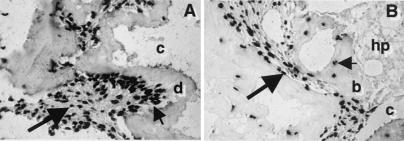Figure 5.
In situ hybridization for the human-specific alu DNA sequence. Alu-positive cells in the pulp tissue (large arrow) and odontoblast-like layer (small arrow) adjacent to the dentin matrix (d) are easily recognized in 6-week DPSC transplants (A). Osteocytes encased in the new bone matrix (small arrow) and the osteoblasts lining the bone (b) surfaces (large arrow) show positive reactivity with the alu probe in the BMSC transplants (B). Hematopoietic elements (hp) in the marrow-like organ fail to show reactivity with the alu probe.

